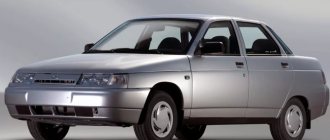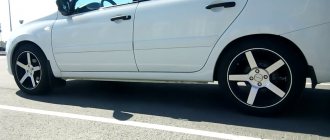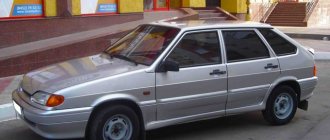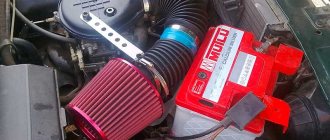According to the Euro-3 European environmental standard, the release into the atmosphere of hydrocarbon vapors that arise during the evaporation of gasoline is prohibited. Taking this into account, scientists have come up with a device that allows them to capture and neutralize the vapors described above.
This “saving” device was the so-called adsorber or, as some call it, “absorber” (from the word absorbent - capable of absorbing, in part, this name can also be considered correct), it is installed in the fuel system of a car in order to eliminate harmful vapors that result from the evaporation of gasoline.
Today, we will try to answer the most popular questions related to the adsorber, so that you can find out what it is, what it is for, and how the fuel system adsorber works. As an example, we will take the VAZ 2110.
The absorbent that absorbs hydrocarbon vapors is coal, which is used to fill the adsorber tank. Where do the pairs come from? Vapors, as mentioned above, are released by gasoline due to heating of the fuel and constant agitation during movement; the vapors rise upward, then through the hole in the neck of the tank they enter the separator. In the separator, the vapors condense and flow back into the tank, and part of the gases that did not have time to go from a gaseous state to a liquid state or, simply put, to become a condensate, flows through the steam line into the gravity valve and directly into the adsorber, which it neutralizes with activated carbon. This process occurs when the motor is not running.
If the engine is running, the control system purges the adsorber by opening the solenoid valve, after which harmful vapors along with air are emitted into the intake pipe, where they are burned.
The benefit of such a system is double, because first of all, there is no pollution of the atmosphere with harmful fumes, in addition, fuel savings occur, since gasoline does not evaporate, but is returned through the separator to the tank.
What is the correct name for an adsorber or absorber?
Both concepts exist in the world. But despite the fact that “sorbeo” and “absorbeo” are translated from the Latin alphabet almost identically: adsorber - (from the Latin Ad - he, with and sorbeo - absorbing) and absorber - (from the Latin absorbeo - I absorb), the semantic load of both words are different.
- In our case, it is an adsorber, since it is a device that absorbs gaseous or soluble substances onto its solid surface without undergoing chemical reactions. There are devices of periodic and continuous action.
- And an absorber is a device that completely absorbs gases (vapors) inside, followed by a chemical reaction, as a result of which one of the substances is completely absorbed by a special liquid (absorber).
Therefore, for our situation, the first option will be correct.
How to adjust the fuel supply process using an electrical circuit?
According to the scheme described above, fuel regulation in a car is carried out. Moreover, it depends not only on the load of the valves in the engine, but also on the corresponding position relative to the throttle valve. With the help of a diagram of electrical wiring and valves, it is possible to understand which of the relays or fuses is malfunctioning and replace it in time. In this case, one of the main roles when supplying fuel is played by electrical equipment (controllers) that regulates the operation of the injector.
Purpose and principle of operation
An adsorber is a container filled with activated carbon that acts as a filter element. This element is the main part of the EVAP system - Evaporative Emission Control (gasoline vapor recovery system).
The system is integrated into the fuel system of cars of Euro-2 standard and higher. You won’t see such adsorbers on classic VAZs and even on model 2108, not to mention Moskvich, Volga 3110, etc.
The goal is to reduce harmful emissions into the atmosphere and eliminate the smell of gasoline in the car interior.
But despite the simplicity of the design, in addition to the housing and the filter element, the adsorber consists of:
- Bends: air supply, inflow, gasoline vapor removal.
- Separator: Here the vapors are condensed and discharged back into the tank.
- Gravity valve (emergency): stops fuel overflow when the machine overturns.
- The solenoid valve (or vacuum valve, for example on some Nissan models) is one of the important elements (more details below).
- Other additional devices (depending on the car model).
The fuel vapors that accumulate in the gas tank must go somewhere. In old cars they escaped into the atmosphere through a special tube. In modern cars, fuel tanks are isolated from the external environment.
Gasoline vapors enter the adsorber through a separate outlet pipe, where they condense into fuel, which is returned to the tank or intake manifold. In the first case, the process occurs with the engine turned off, in the second - with the engine running.
As soon as the car starts, the ECU sends a signal to the solenoid valve. The latter is opened and activated carbon (activated carbon) is blown out. Fuel vapors are “extracted” from the sorbent and immediately enter a special receiver and then into the combustion chamber.
To learn more about what an adsorber is, follow the link.
Schematic diagram of the mounting block
1. block headlight; 2. front brake pad wear sensors; 3. fan motor activation sensor; 4. electric motor of the engine cooling system fan; 5. sound signal; 6. generator: 7. oil level sensor; 8. carburetor solenoid valve control unit; 9. heater controller; 10. recirculation valve switch; 11. illumination lamp for heater control levers; 12. switch; 13. carburetor limit switch; 14. oil pressure warning lamp sensor; 15. spark plugs; 16. carburetor solenoid valve; 17. coolant temperature indicator sensor; 18. ignition distributor sensor; 19. ignition coil; 20. starter; 21. heater fan electric motor; 22. additional resistor for the heater electric motor; 23. speed sensor; 24. reverse light switch; 25. micromotor gearbox for heater damper drive; 26. recirculation valve; 27. brake fluid level sensor; 28. blocks for connecting the rear window washer motor; 29. battery; 30. windshield washer motor; 31. washer fluid level sensor; 32. coolant level sensor; 33. windshield wiper gearmotor; 34. mounting block: 35. blocks for connecting the warning light harness; 36. outdoor lighting switch; 37. instrument cluster; 38. rear fog light switch; 39. fog light indicator lamp; 40. indicator lamp for heated rear window; 41. watch; 42. rear window heating switch; 43. steering column switch; 44. block for switching wires when installing headlights of a different type; 45. instrument lighting regulator; 46. ignition switch; 47. connectors for connecting the headlight cleaner wiring harness; 48. socket for a portable lamp; 49. lamp for individual interior lighting; 50. brake light switch; 51. interior lamp; 52. on-board control system unit; 53. fuel level indicator sensor; 54. hazard warning switch; 55. driver's seat belt sensor; 56. cigarette lighter; 57. ashtray illumination lamp; 58. glove compartment lamp switch; 59. block for connecting the on-board computer; 60. glove box lighting lamp; 61. side direction indicators; 62. switches in the front door pillars; 63. switches in the rear door pillars; 64. parking brake warning lamp switch; 65. trunk lighting; 66. temperature sensor for the heating system; 67. external rear lights; 68. internal rear lights; 69. license plate lights; 70. rear window heating element; 71. block for connecting an additional brake light;
In the instrument panel wiring harness, the second ends of the wires of white, black, orange, white with a red stripe and yellow with a blue stripe are connected to each other at the same points.
The equipment diagrams of the VAZ-2111 and VAZ-2112 cars differ (with the exception of the engine control system) only in the addition of a tailgate washer and cleaner.
1 – VAZ-21102 headlight 2 – front brake pad wear sensors 3 – VAZ-21102 reverse light switch 4 – electric motor of the engine cooling system fan 5 – VAZ-21102 sound signal 6 – right front door locking motor 7 – power relay electric windows 8 – 8 A fuse 9 – VAZ-21102 starter 10 – battery 11 – VAZ-21102 generator 12 – windshield washer motor 13 – washer fluid level sensor 14 – left front door locking motor 15 – left front door power window switch 16 – coolant level sensor 17 – windshield wiper gearmotor 18 – VAZ-21102 recirculation valve 19 – heater damper drive micromotor 20 – VAZ-21102 heater electric motor 21 – trunk lock switch 22 – right front door power window switch 23 – electric window lifter motor nick right front doors 24 – control unit for the door lock system 25 – additional resistor for the heater electric motor 26 – brake fluid level sensor VAZ-21102 27 – electric window motor of the left front door 28 – external lighting switch 29 – instrument cluster 30 – rear fog light switch 31 – indicator lamp fog light 32 – control lamp for heated rear window VAZ-21102 33 – heated rear window switch 34 – steering column switch 35 – instrument lighting switch 36 – ignition switch 37 – mounting block 38 – recirculation valve switch VAZ-21102 39 – heater controller 40 – switch alarm 41 – lamp for illuminating the VAZ-21102 heater control levers 42 – lamp for lighting the glove box 43 – switch for the lamp for lighting the glove box 44 – cigarette lighter 45 – display unit for the on-board control system VAZ-21102 46 – lamp for illuminating the ashtray 47 – brake light switch 48 – left rear door locking motor 49 – power window switch of the left rear door 50 – power window motor of the left rear door VAZ-21102 51 – socket for a portable lamp VAZ-21102 52 – clock VAZ-21102 53 – power window motor of the right rear door 54 – power window switch right rear door 55 – right rear door locking motor 56 – side turn signal 57 – parking brake warning lamp switch 58 – VAZ-21102 driver’s seat belt sensor 59 – directional light 60 – interior light 61 – interior air temperature sensor 62 – switch in the front door pillar of VAZ-21102 63 – switch in the rear door pillar 64 – external rear light of VAZ-21102 65 – internal rear light 66 – license plate lights 67 – trunk light of VAZ-21102
Where is it installed?
As a rule, the adsorber is installed under the hood on the right in the direction of travel of the car, for example, in the VAZ 2110 it has the shape of a barrel.
In other cars, it may be square and installed to the left of the engine (in the direction of travel), under the air duct (Lada Granta), the vacuum brake booster (some Nissan models) or in the radiator area. In the VAZ 2114 it is located next to the battery and air filter.
On the Volkswagen Passat B3, the adsorber is located under the air filter on the right side in the direction of travel.
Other vehicles: Refer to model owner's manual.
Why is the VAZ-2110 electrical circuit needed?
When replacing or repairing an injector with 8 valves, the electrical diagram serves as a kind of guide, with the help of which you can understand all the nuances in the process of connecting specific wiring parts. In addition, the VAZ-2110 electrical diagram when using an injector with 8 valves allows you to understand the functioning of all electrical wiring devices.
In the diagram, the injector valves are evenly spaced, while the system itself is presented in the form of two combined components:
Also, the diagram with 8 and 16 valves indicates the location of the electronic unit, with the help of which the operation of the above two systems is coordinated. Backup equipment, in turn, protects electrical wiring from overloads and increases the operating efficiency of the entire injection system.
Advice: if you are going to repair the injector, be sure to look at the wiring diagram for the VAZ-2106. This will give you the opportunity to replace any faulty parts without affecting the overall functioning of the vehicle's wiring.
The elements indicated by numbers in the diagram are shown below:
The diagram of electrical wires and fuses gives an understanding of the entire operation of the injection system, and also shows the specific position of each of the elements. It contains the following elements:
Why do they refuse the adsorber?
Despite the advantages of this design solution, and these are: fuel economy, absence of odor in the cabin, reduction of harmful emissions into the atmosphere (although many do not care about this), the adsorber has a number of significant drawbacks, because of which many seek to close it or completely remove it.
Disadvantages, they are also signs of malfunction:
- High cost of the product (not for all cars). Replace or remove? More often they prefer the second option. For example, on an Acura MDX the price of a product fluctuates around 10,000 rubles. For VAZ - from 800 rubles.
- A malfunction of the device leads to interruptions in the operation of the unit: the engine does not pull (poor acceleration of the car, damping of lifting, transportation of goods, floating idle speed on a hot engine, if the tank is plastic, then the adsorber is clogged, constantly compresses and opens (in the absence of a bypass valve in the lid ), as a result, it can burst from the pressure of gasoline vapors, if it is metal, it is deformed. Malfunction of the adsorber Hissing when opening the fuel tank cap, caused by the movement of air in the tank (not out) and the smell of gasoline in the cabin, incorrect fuel level. The appearance of error p0443 (cause of malfunction) error - clogged or faulty solenoid valve).
So when a product fails, many people turn it off and remove it, or take the more difficult route of opening the case and replacing the old activated carbon with a new one.
Diagram of a VAZ 21102 passenger car
1 — block headlight VAZ-21102. 35 — instrument lighting switch 2 — front brake pad wear sensors. 36 - ignition switch 3 - reverse light switch. 37 — car mounting block 4 — electric motor of the engine cooling system fan 38 — recirculation valve switch 5 — sound signal. 39 — heater controller 6 — gear motor for locking the right front door lock. 40 - hazard warning switch 7 - relay for turning on electric windows. 41 — lamp for lighting the heater control levers 8 — 8 A fuse. 42 — lamp for lighting the glove box 9 — VAZ-21102 starter. 43 - switch for the glove box lighting 10 - VAZ-21102 battery. 44 — cigarette lighter 11 — generator 45 — on-board control system display unit 12 — windshield washer motor 46 — ashtray lighting lamp 13 — washer fluid level sensor. 47 — brake signal switch 14 — gear motor for locking the left front door lock. 48 — left rear door locking motor 15 — left front door power window switch. 49 — left rear door power window switch 16 — coolant level sensor. 50 — gear motor for the left rear door electric window 17 — gear motor for the windshield wiper. 51 — socket for a portable lamp 18 — recirculation valve. 52 — VAZ-21102 watch 19 — micromotor gearbox for heater damper drive. 53 — electric window motor of the right rear door 20 — electric heater motor. 54 — right rear door power window switch 21 — trunk lock switch. 55 — right rear door locking motor 22 — right front door power window switch. 56 — side turn signal 23 — electric window motor of the right front door. 57 - parking brake warning lamp switch 24 - control unit for the door lock system. 58 — driver’s seat belt sensor 25 — additional resistor for the heater electric motor. 59 — directional lamp 26 — brake fluid level sensor. 60 — interior lamp 27 — electric window motor of the left front door 61 — interior air temperature sensor 28 — exterior lighting switch. 62 — switch in the front door pillar 29 — instrument cluster. 63 — switch in the rear door pillar 30 — rear fog light switch. 64 — external rear light 31 — fog light indicator lamp. 65 — internal rear light 32 — indicator lamp for heated rear window. 66 — license plate lights 33 — rear window heating switch. 67 — trunk light
How to disable or remove the adsorber on a car and do you need to reflash the ECU?
It should be understood that when removing the adsorber, the solenoid valve is turned off, which is connected directly to the controller and is controlled by the latter.
This will result in error p0443, which we already mentioned above. The pipes are also plugged, especially the one that goes to the intake manifold.
What is the disadvantage of such a shutdown?
The fact is that air is constantly drawn in through the pipe going into the intake manifold; even in idle mode, the so-called small purge of the adsorber occurs. At high speeds from 1500 to 2000 and above, a large leak occurs.
The ECU firmware takes into account constant air leaks and fuel vapor consumption during the formation of the air-fuel mixture, despite the fact that all this comes from the mass air flow sensor, the causes of the malfunction of which can be found by clicking on the link.
If you plug the hose, which many people do, a certain amount of air will not get into the intake manifold bypassing the ECU, but the ECU will still take this into account.
That is, the controller takes into account one volume of air, but actually another (smaller) one enters. As a result, the amount of fuel produced by the engine control unit is based on more air than is supplied. This leads to an enrichment of the air-fuel mixture.
As a result, the engine does not perform properly because the mixture is constantly richer in places where it is and is not needed, and fuel consumption increases.
It is also worth talking about the transient mode of engine operation, which can occur when approaching an intersection, a traffic light, a lying policeman, or the moment the gas comes out.
At this moment, a malfunction may occur - a decrease in speed below the minimum. The engine seems to be choking, there is not enough air, the reason is that the mixture is too rich. In a few seconds the situation will be resolved electronically.
Therefore, disabling the adsorber will be correct in the following ways:
- After removing the device, install a nozzle with a diameter of 1 mm in the pipe passing directly in front of the flow meter. This will at least partially solve the problem, since only air without gasoline vapors will be dosed.
- The ECU flashes (difficult). If the test error cannot be resolved, the motor chip may need to be reconfigured, which is expensive.
- Disassembling the entire system with the exception of the solenoid valve, which is at a minimum.
- By installing a resistor (valve emulation) in the electrical circuit of 200 - 250 Ohms and 2 W. To do this, bend the legs of the resistor and insert it into the valve chip. We secure everything with electrical tape. But this doesn't always help.
How to disable the adsorber on a VAZ 2110, 2112, 2114
Taking into account the above recommendations, we do the following:
- Disconnect the power connector from the valve.
- Disconnect all hoses from the adsorber and remove the adsorber along with the caliper.
- We fix the valve in a place where you can reach the plug with wires and pipes.
- Connect a hose with a fuel filter to the lower fitting (see Photo below).
- At the end of the upper fitting: connect the pipe going to the intake manifold.
- On the pipe going to the tank, we place another filter, similar to the first.
With this scheme, when the valve opens, clean air enters the system, albeit without gasoline vapors.
We exclude the valve
This method is even simpler. We disassemble everything, including the valve. We put a fuel filter on the pipe coming from the gas tank, and we dampen the pipe going to the intake manifold with a bolt and clamp.
The consequences of this method are described above, but this method also has a right to life.
As for Priora, Granta, Lada Largus, Gazelle and other cars, turning off the shock absorber is similar to that described above.
Toyota Chaser
It is worth considering one of the foreign cars, for example Toyota Chaser.
The shutdown principle is similar to the previous ones:
- Find the cylinder valve. It is located next to the mass air flow sensor on the air filter housing.
- Disconnect the microcircuit with wires and all hoses from it (the controls on the instrument panel may turn on).
- Find the adsorber, disconnect the pipes from it and connect.
- Disconnect the pipe going to the valve from the throttle assembly and connect it with a bolt to the clamp.
- We put the fuel filter from the VAZ carburetor onto the pipe leading to the tank.
What's the catch in flashing from Euro 4 to Euro 2?
Many people ask for ECUs from Euro-4 to Euro-2; as a rule, this is done when removing the catalyst and installing the mixture. At this point, the adsorption valve may be turned off (intentionally or accidentally), and the ECU does not control the latter and does not control it in any way.
As a result, if the valve fails, the engine will run rough and the error will not be displayed on the instrument cluster. To verify this, close the valve and watch the engine operate.
If the version is confirmed, plug the canister pipes and close the valve; the controller still does not control it.
Electrical diagram of VAZ 21102 injector 8 valves
The VAZ 21102 diagram will be useful for self-repairing a car. It shows all the relays, lights, electric motors and connectors. Repair recommendations: The electronic speedometer does not work - the power circuits of the instrument cluster, speed sensor, and traces of the instrument cluster board are damaged. It is necessary to take care of the terminals, replace faulty wires, and the instrument cluster. The tachometer does not work - the power circuits of the instrument cluster, the tachometer control circuit, and the tracks on the instrument cluster board are damaged. The control lamps do not light up - the socket is poorly pressed to the lamp base or the socket blades are pressed to the printed circuit board, the wires are damaged, their tips are oxidized or loose, the light bulb is burned out. The fuel reserve indicator light is constantly on - the sensor wire is shorted to ground.
FakeHeader
Comments 8
About the effective fight against omissions by eliminating the serial factory circuit jamb www.drive2.ru/b/480194662074679487/
As you write, I’m inclined to think about bad firmware. And you tell me how you fixed the problem with the coil. Not logical. I am a private user of the Icebreaker firmware and recognize it as better than the factory one. Which I am not imposing. But traction is better, consumption is less (by 1.5 liters). Maybe the factory one will be better on your gasoline? (Because the main difference, let’s say, is the quality of the fuel) theoretically it can. In practice, I see more grateful reviews. I understood what I could do with the adsorber. Thanks for the tip!











